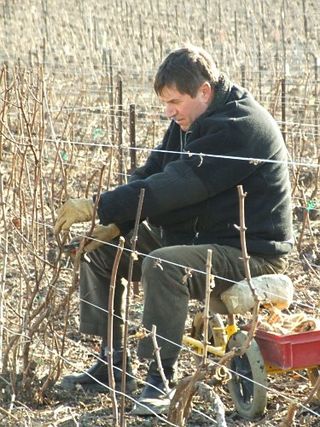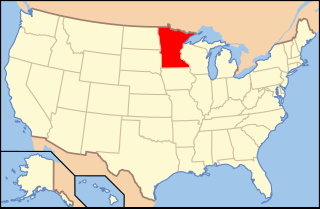
A vineyard is a plantation of grape-bearing vines, grown mainly for winemaking, but also raisins, table grapes, and non-alcoholic grape juice. The science, practice and study of vineyard production is known as viticulture. Vineyards are often characterised by their terroir, a French term loosely translating as "a sense of place" that refers to the specific geographical and geological characteristics of grapevine plantations, which may be imparted to the wine itself.

Vitis vinifera, the common grape vine, is a species of flowering plant, native to the Mediterranean region, Central Europe, and southwestern Asia, from Morocco and Portugal north to southern Germany and east to northern Iran. There are currently between 5,000 and 10,000 varieties of Vitis vinifera grapes though only a few are of commercial significance for wine and table grape production.
Oenology is the science and study of wine and winemaking. Oenology is distinct from viticulture, which is the science of the growing, cultivation, and harvesting of grapes. The English word oenology derives from the Greek word oinos "wine" and the suffix –logia the "study of". An oenologist is an expert in the science of wine and of the arts and techniques for making wine.

A winemaker or vintner is a person engaged in winemaking. They are generally employed by wineries or wine companies, where their work includes:

Wine Australia is an Australian Government statutory corporation that promotes and regulates the Australian wine industry. It was created as the Australian Wine and Brandy Corporation (AWBC) in 1981 to replace the Australian Wine Board by the Australian Wine and Brandy Corporation Act 1980, and had its name changed by the amended Wine Corporation Act 1980, passed in December 2010. Wine Australia is now governed by the superseding law, Wine Australia Act 2013. Wine Australia determines the boundaries of Australia's wine regions and sometimes names them. Wine Australia also regulates wine exports, ensuring the quality and integrity of each shipment of wine exported. Wine Australia has three main departments; Compliance, Market Development and Knowledge Development.

The following outline is provided as an overview of and topical guide to wine:
The Australian Wine Research Institute (AWRI) is a research institute with a focus on Australian wine, based in Adelaide, South Australia.

Helmut Becker was a German viticulturist, and was chief of the Geisenheim Grape Breeding Institute. As a successor of Heinrich Birk, he viewed viticulture from a global perspective and promoted the globalization of a quality wine industry. Dr. Becker collaborated with numerous scientists around the world and encouraged the importation of important clones and varieties in New Zealand, Canada, Australia, Japan and other countries. He did early important work in Neustadt/Weinstrasse during the 1950s and 1960s in the European phylloxera eradication program.
The Australian and New Zealand Wine Industry Journal published a wide range of articles from technical and scientific papers to practical advice and the latest news on research and development. The journal was issued six times a year and featured practical winemaking, practical grape growing, articles on wine regions and wine styles, vintage reports, marketing, finance and management, research papers, and industry news and analyses. In 2010 the magazine merged with Australian Viticulture to form a new wine magazine, Wine & Viticulture Journal.
The American Society for Enology and Viticulture, founded in 1950, is a non-profit, scientific wine production industry organization headquartered in Davis, California.
The Winkler Index, sometimes known as the Winkler Scale or WinklerRegions, is a technique for classifying the climate of wine growing regions based on heat summation or growing degree-days. In the system, geographical areas are divided into five climate regions based on temperature converted to growing degree-days, and is commonly known as Regions I–V. The system was developed at the University of California, Davis by A. J. Winkler and Maynard Amerine.

Minnesota wine refers to wine made from grapes grown in the U.S. state of Minnesota. Minnesota is part of the largest American Viticultural Area (AVA), the Upper Mississippi River Valley AVA, which includes southwest Wisconsin, southeast Minnesota, northeast Iowa, and northwest Illinois. The state also has a smaller designated American Viticultural Areas, the Alexandria Lakes AVA. Minnesota is a very cold climate for viticulture and many grape varieties require protection from the winter weather by being buried under soil for the season. Minnesota is home to extensive research on cold-hardy French hybrid and other grape varieties.

Arizona wine refers to wine made from grapes grown in the U.S. state of Arizona. There are three major regions of vineyards and wineries in Arizona:

Château La Tour Blanche, or La Tour-Blanche, is a sweet white wine ranked as Premier Cru Classé in the original Bordeaux Wine Official Classification of 1855. Belonging to the Sauternes appellation in Gironde, in the region of Graves, the winery is located in the commune of Bommes.
Ann C. Noble is a sensory chemist and retired professor from the University of California, Davis. During her time at the UC Davis Department of Viticulture and Enology, Noble invented the "Aroma Wheel" which is credited with enhancing the public understanding of wine tasting and terminology. At the time of her hiring at UC Davis in 1974, Noble was the first woman hired as a faculty member of the Viticulture department. Noble retired from Davis in 2002 and in 2003 was named Emeritus Professor of Enology. Since retirement she has participated as a judge in the San Francisco Chronicle Wine Competition.
Precision viticulture is precision farming applied to optimize vineyard performance, in particular maximizing grape yield and quality while minimizing environmental impacts and risk. This is accomplished by measuring local variation in factors that influence grape yield and quality and applying appropriate viticulture management practices. Precision viticulture is based on the premise that high in-field variability for factors that affect vine growth and grape ripening warrants intensive management customized according to local conditions. Precision viticulture depends on new and emerging technologies such as global positioning systems (GPS), meteorologic and other environmental sensors, satellite and airborne remote sensing, and geographic information systems (GIS) to assess and respond to variability.
Alberto Antonini is an Italian oenologist and grower-producer, as well as a consultant to a large number of wineries in various countries including Italy, the U.S., Argentina, Canada, Chile, Uruguay, Armenia and Australia.

British Columbia wine is Canadian wine produced in the province of British Columbia. Wines made from 100% British Columbia grapes can qualify for classification under one of British Columbia's two classification systems, depending on the variety, the winemaking techniques employed, and various other restrictions.

The California Association of Winegrape Growers (CAWG) was established in 1974 as an advocate for California's wine grape growers, providing leadership on research and education programs, public policies, sustainable farming practices and trade policy to enhance the California wine grape growing business and communities. According to their website, major objectives of CAWG's advocacy are: improvements in industry statistical data, funding for viticultural research, reform of federal estate tax law, and preventing misleading grape origin and varietal information on wine labels.
Terence Henderson Lee OAM is a former cricketer who played first-class cricket for New South Wales from 1962 to 1967. He later became prominent in research and development in the Australian wine industry, work for which he was awarded the Medal of the Order of Australia in 2007.










